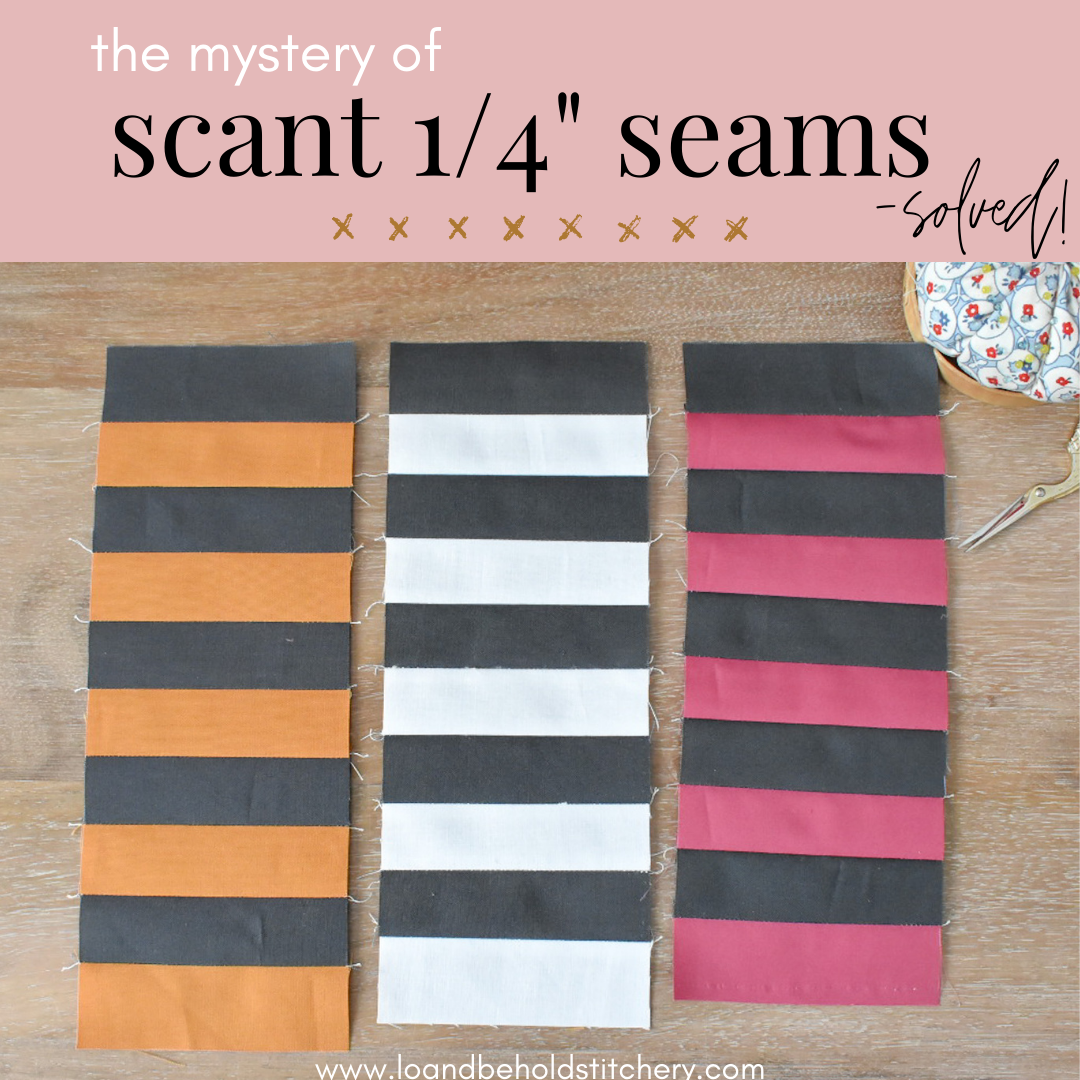The Mystery of the Scant 1/4" Seam - SOLVED!

It's widely known that quilters sew with a 1/4" seam. But have you ever heard of a scant 1/4" seam? I remember the first time that I heard this term, I thought it was a bunch of malarky. I refused to believe that it needed to be a "thing". I had it in my mind that if I just ignored it's existence, maybe I would never have to confront reality. (hah!) Well, my friends, the reality is.... scant 1/4" seams really aren't as daunting as you probably think they are.... or as least as what I made them out to be in my mind! The truth of the matter is: the term itself is actually scarier that what it actually means.

The quilt featured above is the Deco quilt pattern.
.
"Scant Quarter Inch" Definition
So what exactly does "scant" mean? The technical definition is that it's a "thread-width smaller than a true 1/4".
I was pretty mad when I heard this for the first time. Why isn't a true 1/4" seam good enough? Who would decide to use a scant 1/4" seam just for fun-sies? Well, I quickly learned my lesson the hard way when I went to create my Interwoven quilt pattern and I was running into MAJOR issues.
It turns out, when you press your seams (either open or to one side), you lose a tiny bit of your fabric as it has to fold around your seam. This can vary from person to person based on what kind of thread you are using (ply and weight), how you are pressing your seams (open vs. one side), how well that seam is pressed and how many seams are in a block.
Say that hypothetically, the the width of the thread and or the fold of the fabric as it goes *around* the thread accounts for 1/32'nd of an inch. Pretty small right? You might not notice this if you only have three seams in a block. 3 x (1/32") = less than a tenth of an inch. But what if you have 9 seams in a block? 9 x (1/32") adds up to over 1/4"!
Check out the example below. When you sew ten 1.5" strips together using a 1/4" seam, in theory they should measure 10.5". (10 x 1.5" = 15"... subtract 4.5" of seam allowances = 10.5"). With the strip set on the left, I used a seam allowance that was way too narrow. You can see that it came out to measure larger than 10.5". The strip set on the far right was constructed using a *true* 1/4" and it came out shorter than what I needed. I used a *scant* 1/4" seam to create the strip set in the middle and that did the trick!
.

.
When to use a Scant 1/4 Inch Seam
When I shifted my mindset from thinking about a scant 1/4" seam as a definitive measurement to more of a fluid adjustment, I began to understand the nature of what happens to my seams based on the following factors:
- The Pattern or Piecing Technique - Before you start any new project or technique, it's always important to try a test block first. For example, your seam allowance will likely need to vary slightly if you are sewing 10 strips together versus only 3. The more pieces that are in a block, the more likely it is that you'll need to use a scant 1/4". Hence why Deco, Interwoven, Rhythm and Knitted Star all suggest a scant 1/4" seam. These patterns have blocks that have lots of piecing so there are many opportunities for your seam allowance to become "off" in the process. There are also certain piecing techniques, such as "stitch and flip" or the snowball technique that would benefit from a scant 1/4" seam as well.

- Thread Thickness - 50 weight thread is typically preferred for piecing. If you sew with 40 weight thread or anything thicker, you will likely notice an effect on the accuracy of your seam allowance.
- Pressing Direction - Generally speaking, pressing your seams open will give you a more accurate measurement than pressing a seam to one side. This is because when you press your seam to one side, the fabric has a higher chance of creating a larger fold around the seam. Open seams are generally flatter and more precise. That being said, MANY people press their seams to one side and have great results. I'm not knocking pressing seams to one side! I've only noticed (in my own work) that when I press a seam open, I generally have more accurate results, especially if I'm sewing with a scant 1/4" seam. If you are wanting to press your seam to one side, be sure that the nose of your iron gently gets into the seam so that there isn't a fold. I've also noticed that things like a wool pressing mat and tailor's clapper really help with flat seams.
- Fabric Thickness - You might notice that you have to adjust your seam allowance with thicker fabrics. I notice a slight difference between using Art Gallery and Kona Solids. Kona seems to be a little more stiff and thick, meaning that slightly more fabric may get "eaten up" by the seam allowance.
.
.
Do I have to use a Scant 1/4" as long as I'm Consistent?
Yes, no and maybe! It really depends on the pattern. For some patterns, it really only matters that your seams are consistent. You might be able to get away with using a certain seam allowance and you'll just have a slightly smaller or larger quilt in the end. For example, if you are making a quilt that is entirely made up of squares, like the one seen below, you can technically use whatever seam allowance you wish to use and it will not make a difference in the end. As long as you are consistent.

.
For most quilt patterns (my own included) the blocks may not look right within your quilt if they are not accurate. For example, with Homecoming and Interwoven, you really want the blocks to measure accurately, otherwise, the lines created within the quilt will not 100% connect from block to block. In the end, this may not bother you, but it can be pretty noticeable. It's better to take 10 or 20 minutes to perfect your seam allowance to have better results than to have inaccurate blocks.... in my humble opinion. :)

The quilt featured above is the Interwoven quilt pattern.
.
How to Test your Seam Allowance
Remember that a scant 1/4" seam is nothing more than an adjustment. Everyone's scant is going to look different based off of the factors listed above. The biggest piece of advice that I have is to make a test block. If the pattern calls for 8 seams in one block, recreate that with some test fabric and make sure that it measures what it should.
If the test block is larger than what it should measure, then your seam allowance is too scant. If the test block is smaller than what it should measure, then your seam allowance is too big.
If you would like to follow along in an exercise, cut (10) 1.5" x 4" pieces of fabric. Sew the pieces of fabric together lengthwise to create a unit, as seen below. As you are sewing your ten 1.5"x 4" strips together, measure your strips. If a strip is in the middle of two strips, it should measure 1". Outside strips (only one sewn edge) should measure 1.25". If your middle strips are larger than 1", your seam allowance is too scant. If they're smaller than 1", your seam allowance needs to be more scant. This may take some trial and error, so repeat this exercise until you find the sweet spot. After sewing all 10 pieces of fabric together, the finished unit should measure 10.5".
Remember that measuring the final block, rather than the inside of the individual seam will give you a more accurate depiction of what is going on, but take a look at the photos below to see approximately where your seams should be.

.

.
.
How to Adjust your Seam Allowance
If your block measures *smaller* than what it should be then your seam allowance was too large. You will need to make your seam allowance smaller (more scant). You can do this by moving your needle to the right, or moving your fabric to the left.
If your block measures *larger* than what it should be then your seam allowance was too small. You will need to make it larger (less scant). You can do this by moving your needle to the left or moving your fabric to the right.
Needle Position & Presser Foot
If you use a 1/4" seam presser foot, pay attention to your needle position. You may need to adjust it a little to achieve a scant 1/4". The fabric might need to be right up against the guide bar, or only lightly touching it. While a 1/4" presser foot is helpful, it is not the end-all be-all for accuracy. You still might need to make small adjustments. For example, with my 1/4" presser foot, I have to move my needle all the way over to the right. If your sewing machine needle does not move from left to right, then you may not benefit from a 1/4" presser foot. You can find a 1/4" presser foot on Amazon. This is a universal presser foot, so be sure to check and make sure that it will work with your specific machine.

Personally, I started piecing with an HP (High Performance) foot a few months ago on my Janome M7. You can see below that in order for me to achieve a scant 1/4" seam, I align my fabrics so that it is just under the right edge of my presser foot.

.
Create a Landmark
If your needle position doesn't move and/or you have limited presser feet options, you may need to create a landmark on your sewing machine so that you know where to line up your fabric. You can do this with something like masking tape or diagonal seam tape. If you want to create a "ridge" on your machine for the fabric to butt up against, consider taping a stack of index cards or something similar to your machine.

.
.

The quilt featured above is the Knitted Star quilt pattern.
.
Remember that scant 1/4" seams don't have to be a big deal. Taking the time to adjust and practice what kind of seam allowance you need in order to achieve accurate blocks can really save you from stress in the long-run. I hope this post helps you do just that!
.
Happy sewing,
Brittany


